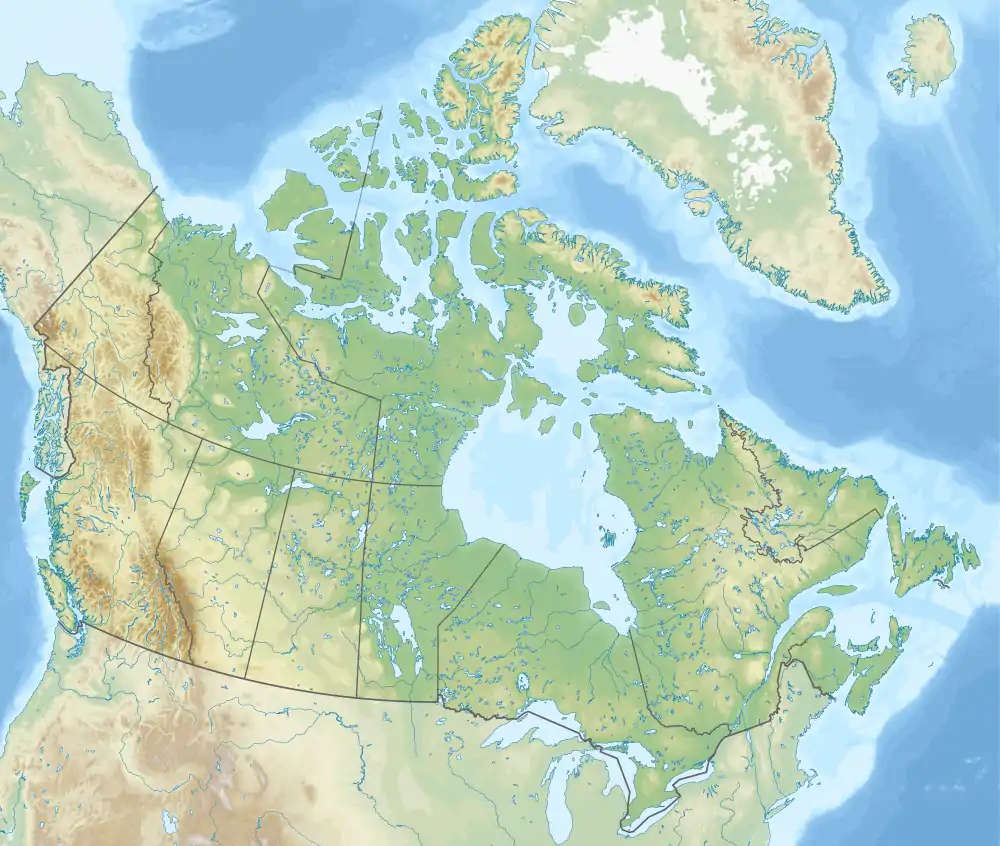Bluefish Caves
Bluefish Caves is an archaeological site in Yukon, Canada, located 54 km (34 mi) southwest of the Vuntut Gwichin community of Old Crow, from which a human-worked jaw bone of a Yukon horse has been radiocarbon dated to 24,000 years before present (BP),[1] earlier than the generally accepted age for habitation of the New World.[2] There are 3 small caves in the area.[3]
 location in Canada | |
| Location | near the Vuntut Gwichin community, Old Crow |
|---|---|
| Region | Yukon, Canada |
| Coordinates | 67°09′N 140°35′W |
| History | |
| Founded | 24,000 BP |
Context
Bluefish Cave was initially known to the local First Nations, but was popularized by a fishing expedition in 1976, and later by researchers. This site is made up of three small caves, ranging from 10 to 30 m3 (350 to 1,060 cu ft).[4] The first cave contains various animal bones that appear to have been dragged there by predators, but findings of tool marks and some tools themselves point to a human presence.[5]
The Old Crow Flats, another important area with early human presence, are located about 75 km northeast of the Bluefish Caves.[6]
Dating
The site was excavated by archaeologist Jacques Cinq-Mars between 1977–87, and the initial radiocarbon dating suggested an age of 24,000 before present (BP).[7] This was considered controversial as it was in contrast to the Clovis-First theory, widely accepted by academics at the time, which considered the earliest settlement date of North America to be around 13,000 BP.[2] A review of the site in 2017 found it to be 24,000 years old,[8] lending support to the "Beringian standstill" hypothesis - that the ancestors of Native Americans spent considerable time isolated in a Beringian refuge during the Last Glacial Maximum before populating the Americas.[9]
See also
References
- Magazine, Hakai. "Archaeological Find Puts Humans in North America 10,000 Years Earlier Than Thought". Hakai Magazine. Retrieved 2020-11-18.
- Curry, Andrew (2012-05-03). "Ancient migration: Coming to America". Nature. 485 (7396): 30–32. doi:10.1038/485030a. PMID 22552076.
- Heather Pringle (MARCH 8, 2017), What Happens When an Archaeologist Challenges Mainstream Scientific Thinking? -- The story of Jacques Cinq-Mars and the Bluefish Caves shows how toxic atmosphere can poison scientific progress. Hakai Magazine, SMITHSONIAN.COM
- "Significance of the Bluefish Caves in Beringian Prehistory | Essays | Resources For Scholars | Research | Learn | Canadian Museum of History". www.historymuseum.ca. Retrieved 2017-01-11.
- Saraceni, Jessica E. "New Thoughts on the Bones from Bluefish Caves - Archaeology Magazine". www.archaeology.org. Retrieved 2017-01-11.
- J. Cinq-Mars (2001), On the significance of modified mammoth bones from eastern Beringia.
- Harington, CR; Cinq-Mars, J (2008). "Bluefish Caves- Fauna and Context" (PDF). Beringian Research Notes. 19. Archived from the original (PDF) on 2018-11-10. Retrieved 2017-01-11.
- Bourgeon, Lauriane; Burke, Ariane; Higham, Thomas (2017-01-06). "Earliest Human Presence in North America Dated to the Last Glacial Maximum: New Radiocarbon Dates from Bluefish Caves, Canada". PLOS One. 12 (1): e0169486. doi:10.1371/journal.pone.0169486. ISSN 1932-6203. PMC 5218561. PMID 28060931.
- "On Way to New World, First Americans Made a 10,000-Year Pit Stop". 2017-02-27. Retrieved 2017-01-11.
Further reading
- Heather Pringle (MARCH 8, 2017), What Happens When an Archaeologist Challenges Mainstream Scientific Thinking?—The story of Jacques Cinq-Mars and the Bluefish Caves shows how toxic atmosphere can poison scientific progress. Hakai Magazine, SMITHSONIAN.COM
- The Bluefish Caves in Beringian Prehistory by Jacques Cinq-Mars, Archaeological Survey of Canada